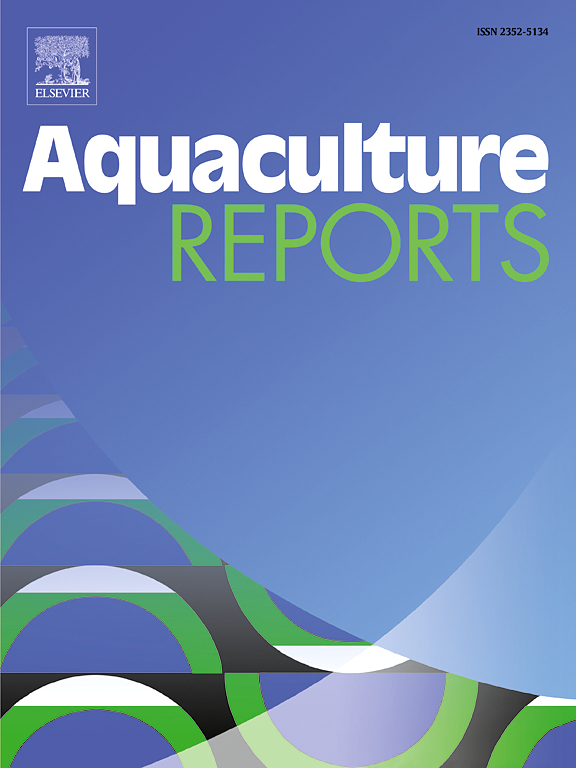Genetic diversity of Gymnocypris firmispinatus: Insights from microsatellites and mitochondrial DNA among wild, broodstock source, and broodstock populations
IF 3.2
2区 农林科学
Q1 FISHERIES
引用次数: 0
Abstract
This study provides an analysis of the genetic diversity and population structure of Gymnocypris firmispinatus, a fish species endemic to the upper Yangtze River. Genetic evaluations were conducted using both microsatellite and mitochondrial DNA (mtDNA) markers across three distinct populations: wild, broodstock source, and broodstock. The results show that genetic diversity is relatively uniform across these groups, with no significant differences observed in diversity levels. The wild population had an average of 15.889 alleles per locus, the broodstock source population had an average of 16.444 alleles per locus, and the broodstock population had an average of 13.778 alleles per locus, with an average polymorphic information content (PIC) of 0.883. The observed heterozygosity (Ho) and expected heterozygosity (He) averaged 0.729 and 0.894, respectively. mtDNA (5’-Cyt b + D-loop-3’) analysis revealed 36 haplotypes with an overall haplotype diversity (h) of 0.901 and an overall nucleotide diversity (π) of 0.00476. Genetic differentiation was significant, particularly between the wild and broodstock populations, as indicated by high Fst values for both microsatellite and mtDNA markers. The broodstock population presented a high level of diversity with microsatellite markers (Ho = 0.737, He = 0.798, PIC = 0.769), whereas mtDNA markers presented comparatively lower diversity (h = 0.563, π = 0.00079). This contrast highlights the importance of using both marker types to gain a complete understanding of the genetic structure of populations. The reduced mtDNA diversity is likely due to its smaller effective population size and greater susceptibility to genetic drift, given its maternal inheritance. These findings suggest that stock enhancement release activities can help preserve the genetic diversity of the G. firmispinatus population.
firmispinatus裸鱼的遗传多样性:来自野生、亲鱼来源和亲鱼种群的微卫星和线粒体DNA的见解
本文对长江上游特有鱼类firmispinatus的遗传多样性和种群结构进行了分析。利用微卫星和线粒体DNA (mtDNA)标记对三个不同种群:野生种群、亲鱼种群和亲鱼种群进行遗传评估。结果表明,各类群遗传多样性基本一致,多样性水平差异不显著。野生种群平均每个位点有15.889个等位基因,亲本源种群平均每个位点有16.444个等位基因,亲本种群平均每个位点有13.778个等位基因,平均多态性信息含量(PIC)为0.883。观察杂合度(Ho)和期望杂合度(He)平均分别为0.729和0.894。mtDNA (5 ' -Cyt b + D-loop-3 ')分析显示36个单倍型,总单倍型多样性(h)为0.901,总核苷酸多样性(π)为0.00476。遗传分化是显著的,特别是在野生种群和亲鱼种群之间,微卫星和mtDNA标记的Fst值都很高。微卫星标记表明亲鱼种群多样性较高(Ho = 0.737, He = 0.798, PIC = 0.769), mtDNA标记多样性较低(h = 0.563, π = 0.00079)。这种对比突出了使用这两种标记类型以获得对种群遗传结构的完整理解的重要性。mtDNA多样性的减少可能是由于其有效种群规模较小,并且由于其母系遗传,更容易发生遗传漂变。这些结果表明,种群增强释放活动有助于保护沙棘种群的遗传多样性。
本文章由计算机程序翻译,如有差异,请以英文原文为准。
求助全文
约1分钟内获得全文
求助全文
来源期刊

Aquaculture Reports
Agricultural and Biological Sciences-Animal Science and Zoology
CiteScore
5.90
自引率
8.10%
发文量
469
审稿时长
77 days
期刊介绍:
Aquaculture Reports will publish original research papers and reviews documenting outstanding science with a regional context and focus, answering the need for high quality information on novel species, systems and regions in emerging areas of aquaculture research and development, such as integrated multi-trophic aquaculture, urban aquaculture, ornamental, unfed aquaculture, offshore aquaculture and others. Papers having industry research as priority and encompassing product development research or current industry practice are encouraged.
 求助内容:
求助内容: 应助结果提醒方式:
应助结果提醒方式:


